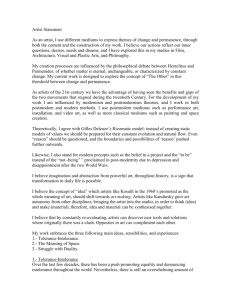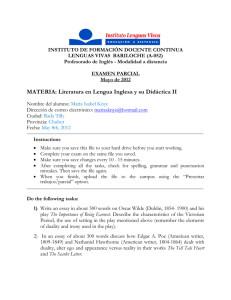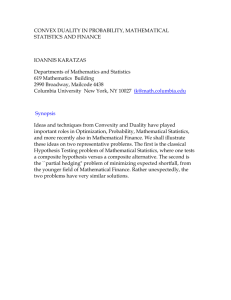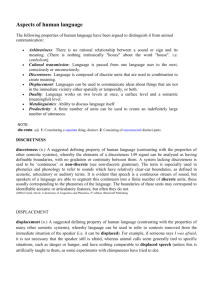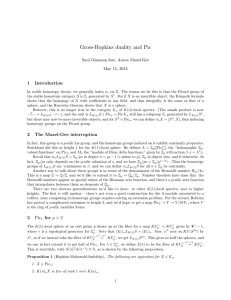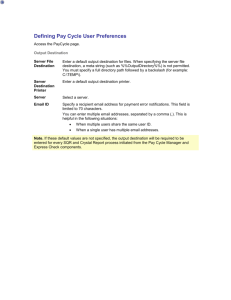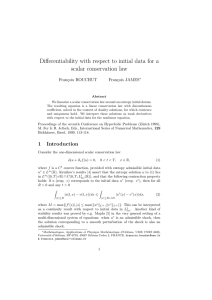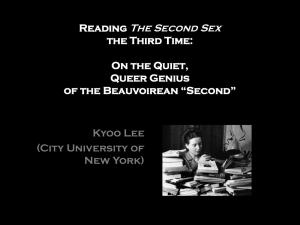Nine function modes
advertisement
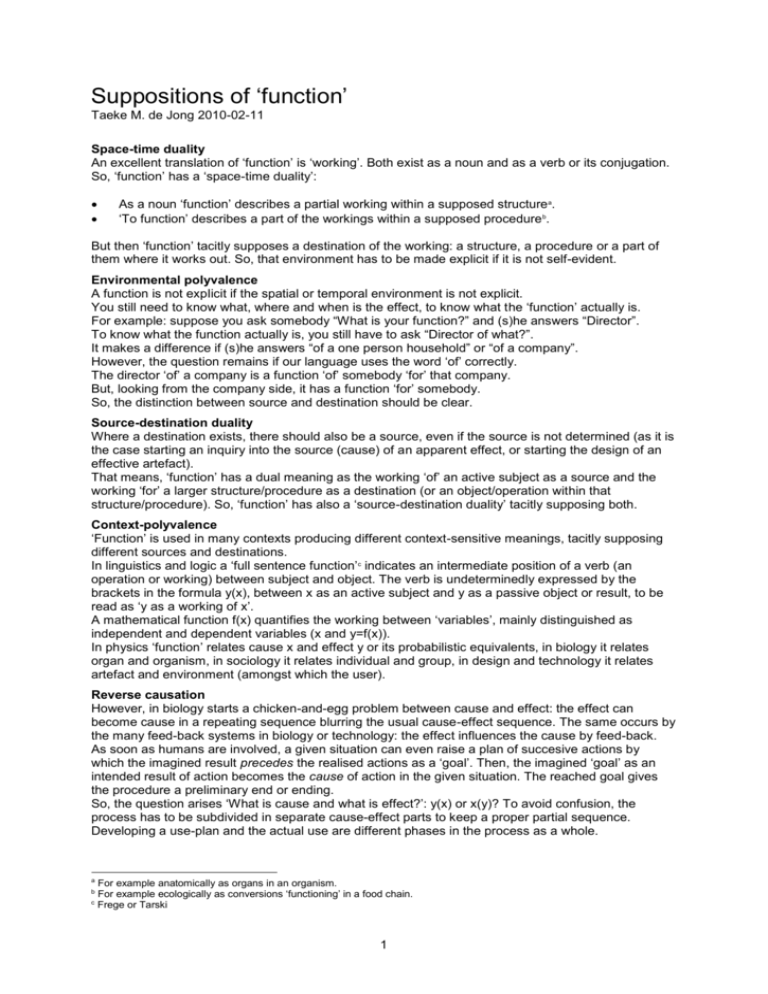
Suppositions of ‘function’ Taeke M. de Jong 2010-02-11 Space-time duality An excellent translation of ‘function’ is ‘working’. Both exist as a noun and as a verb or its conjugation. So, ‘function’ has a ‘space-time duality’: As a noun ‘function’ describes a partial working within a supposed structure a. ‘To function’ describes a part of the workings within a supposed procedure b. But then ‘function’ tacitly supposes a destination of the working: a structure, a procedure or a part of them where it works out. So, that environment has to be made explicit if it is not self-evident. Environmental polyvalence A function is not expIicit if the spatial or temporal environment is not explicit. You still need to know what, where and when is the effect, to know what the ‘function’ actually is. For example: suppose you ask somebody “What is your function?” and (s)he answers “Director”. To know what the function actually is, you still have to ask “Director of what?”. It makes a difference if (s)he answers “of a one person household” or “of a company”. However, the question remains if our language uses the word ‘of’ correctly. The director ‘of’ a company is a function ‘of’ somebody ‘for’ that company. But, looking from the company side, it has a function ‘for’ somebody. So, the distinction between source and destination should be clear. Source-destination duality Where a destination exists, there should also be a source, even if the source is not determined (as it is the case starting an inquiry into the source (cause) of an apparent effect, or starting the design of an effective artefact). That means, ‘function’ has a dual meaning as the working ‘of’ an active subject as a source and the working ‘for’ a larger structure/procedure as a destination (or an object/operation within that structure/procedure). So, ‘function’ has also a ‘source-destination duality’ tacitly supposing both. Context-polyvalence ‘Function’ is used in many contexts producing different context-sensitive meanings, tacitly supposing different sources and destinations. In linguistics and logic a ‘full sentence function’ c indicates an intermediate position of a verb (an operation or working) between subject and object. The verb is undeterminedly expressed by the brackets in the formula y(x), between x as an active subject and y as a passive object or result, to be read as ‘y as a working of x’. A mathematical function f(x) quantifies the working between ‘variables’, mainly distinguished as independent and dependent variables (x and y=f(x)). In physics ‘function’ relates cause x and effect y or its probabilistic equivalents, in biology it relates organ and organism, in sociology it relates individual and group, in design and technology it relates artefact and environment (amongst which the user). Reverse causation However, in biology starts a chicken-and-egg problem between cause and effect: the effect can become cause in a repeating sequence blurring the usual cause-effect sequence. The same occurs by the many feed-back systems in biology or technology: the effect influences the cause by feed-back. As soon as humans are involved, a given situation can even raise a plan of succesive actions by which the imagined result precedes the realised actions as a ‘goal’. Then, the imagined ‘goal’ as an intended result of action becomes the cause of action in the given situation. The reached goal gives the procedure a preliminary end or ending. So, the question arises ‘What is cause and what is effect?’: y(x) or x(y)? To avoid confusion, the process has to be subdivided in separate cause-effect parts to keep a proper partial sequence. Developing a use-plan and the actual use are different phases in the process as a whole. a For example anatomically as organs in an organism. For example ecologically as conversions ‘functioning’ in a food chain. c Frege or Tarski b 1 Scale-sensitivity In all of these actual environments and imagined contexts the meanings of ‘function’ differ substantially at different levels of scale and time spans. For example: CO2 has a different function for a plant in its life time compared to its function for the Earth during its existence. And, since there are many tacitly supposed levels of scale, there are many boundaries between them leading to a confusion of tongues. So, to speak about a function without mentioning the supposed spatial or temporal level of scale mainly leads to confusion. Boundary duality But, even if the level of scale is explicit, a boundary between two levels of scale has two faces: an ’internal’ and an ‘external’ side. In that case, ‘function’ may concern both the internal and the external action: how does it work (operation) and which work does it (performance) a? This may look similar to the source-destination duality determining the boundary, but it is the reverse: here the boundary determines the source or destination (as often happens in design). For example: a wall separates, but what from what? Here, the wall is the active subject and the passive object is the difference between the environments at both sides, be it source or destination. Reverse scale causation However, there is still an other necessary distinction of meaning. Until here, we supposed a subject can have a function for a larger environment or more specific an object within that environment (in that case neglecting side-effects for other objects). But, the reverse, an environment also can have a ‘function’ for its smaller elements (ecology!). In sociology that inward approach was mainly accepted since the sixties as ‘structural functionalism’ b. It evoked a reaction of ‘symbolic interactionists’ c wanting to clarify society from individual into group. The approach from small into large got the name ‘anascopic’, from large into small ‘katascopic’d. Not distinguishing both is another source of confusion. For example: a ball can be described anascopically as concave and katascopically as convex. A chairman searching for a compromise could propose that the ball has an undulating form. Many compromises in science show that bias. The function of a tool for its user is mainly anascopic, but the function of a house for its inhabitants is katascopic. Normative duality Normative is any suppostion about the impact of human action on the life expectancy of living sets. ‘Life expectancy’ supposes a time left to live and its ‘value’. ‘Living set’ may be individuals (liberal values), families (confessional values), communities (social values) or even include other life forms. From sociology we owe the distinction between eufunction and dysfunction. For the survival of a society a citizen practising its values is mainly supposed to be eufunctional, a criminal dysfunctional. In biology eating is eufunctional, but to be eaten is dysfuctional. Even ‘using’ mainly in the same time means withdrawing from other potential use. So, many – if not all - eufunctions may have dysfunctional side effects and ‘functional’ has two normative faces to be balanced as a value of survival. However, the word ‘function’ is often implicitly used as ‘eufunction’. We can say ‘not functional’ if we mean ‘not eufunctional’. The word ‘malfunction’ supposes a disappointing ‘eufunction’ as a ‘proper function’, but not a ‘dysfunction’. For example: to provide families a safe and warm house may have bad effects at a larger scale by exhausing energy resources or at a smaller scale making the inhabitants more vulnerable if they get used to a safe and warm environment. The distinction between eufunction and dysfunction is sensitive for any other mode of the term ‘function’. Being explicit about the other modes is a necessary condition for any evaluative judgement. Nine function modes So, speaking about ‘function’ requires to be explicit in its: 1. Space-time duality (a function within a structure between other functions or functioning in the sequence of a procedure) 2. Environmental polyvalence (what is affected) 3. Source-destination duality (a function ‘of’ a source or ‘for’ a destination) 4. Context-polyvalence (physics, biology or anthropology) a Tzonis Parsons c Zijderveld d Berting? b 2 5. 6. 7. 8. 9. Reverse causation (cause determines effect or imagined effect precedes action as cause) Scale-sensitivity (frame and grain demarcating the functioning subject and the affected object) Boundary duality (function as internal operation or external performance at a given level of scale) Reverse scale causation (anascopic or catascopic function) Normative duality (eufunction or dysfunction for individuals, families, communities or any other form of life) 3
